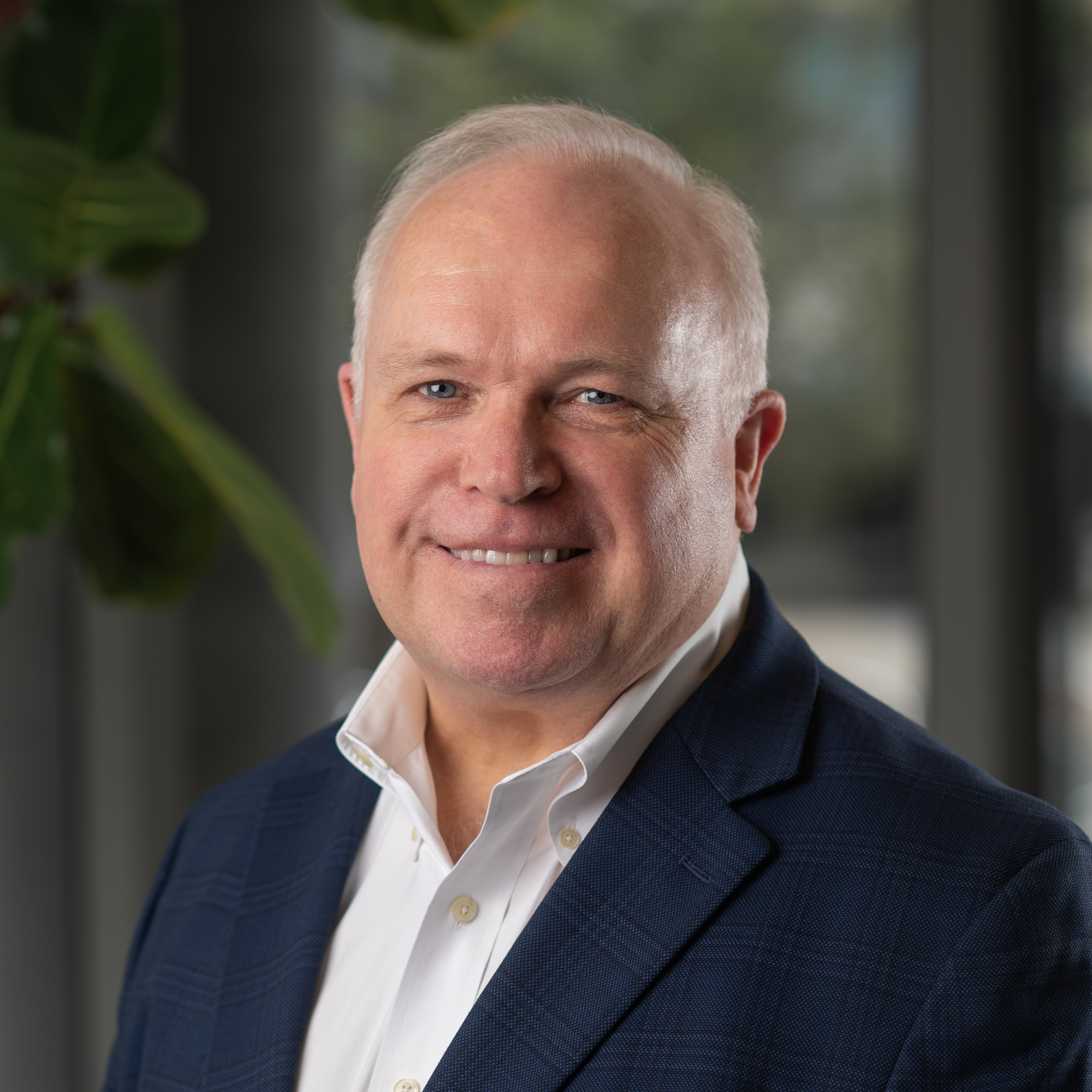All posts by Gary Stockton

Commercial fraud prevention causing unintended harm We often hear anecdotes from our clients about a recent string of bad debt, soliciting advice on how best to prevent future losses. Typically, with an increase in credit loss, maybe your natural reaction is to tighten up on credit evaluation criteria to screen out look-alikes? In so doing, you can also impact the ability to grow, and in the process, exclude good customers by retooling your lending criteria, weeding out fraud. In our upcoming 15-minute Sip and Solve webinar, we'll explore whether tightening your credit score cards could unintentionally cause dozens, hundreds, thousands of small businesses not to receive the credit they deserve. Date: Thursday, April 22nd, 2021 Time: 10:30 a.m. (Pacific) 1:3- p.m. (Eastern) Session highlights Find out why misclassifying losses due to fraud as credit write-offs could impact your ability to grow your business. Learn more about delinquent small business credit behaviors versus small businesses looking to commit fraud. Discover how you can assess whether past charge-offs were actually due to fraud. Save my seat
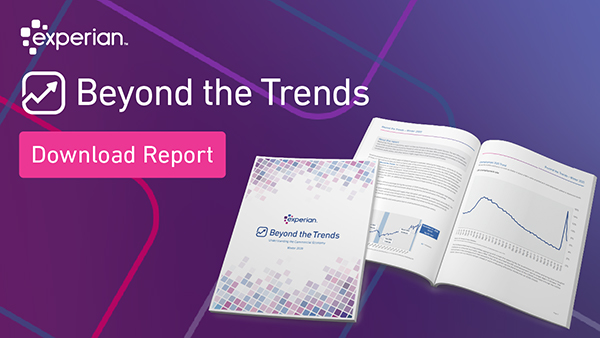
Beyond the Trends Spring 2021 - now available We're excited to announce the release of our second Beyond the Trends report. This report's going to deep dive into the economic trends that we're seeing in the market now. We look at some commercial and consumer credit trends that will impact recovery. And we'll deep dive into some of the industries that are most impacted. One of the things we talk about in this edition is economic growth. As excitement builds within the markets and reopening continues across different regions, we see an expectation for 7% GDP growth in the U.S. We're seeing a 27% increase in business starts year-over-year, and businesses reopened. We have new businesses emerging as well. In this report, we'll look at ways that lenders, as well as businesses, will be seen in credit markets and how growth can occur. Finally, with new stimulus in the market, consumers are ready to spend. Small businesses will look for opportunities to move from security mode and safety mode, business preservation into a transformational growth mode. Stay informed by downloading your copy of the Beyond the Trends report. Download the latest report
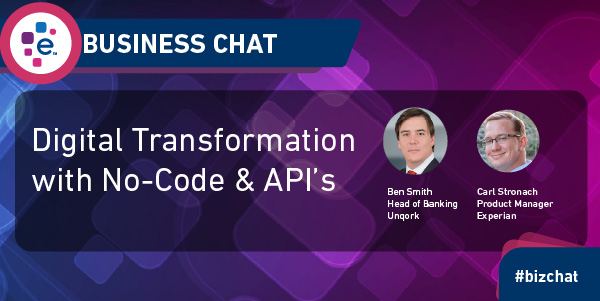
In the wake of the Coronavirus Pandemic, thousands of companies were forced to go digital, transforming brick and mortar experiences to mobile-enabled, touchless digital experiences. Whether you were a small grocery chain or a family restaurant getting plugged into a myriad of takeout ordering platforms, the choice was simple, upgrade to a fully digital experience or go extinct. When the $2.2 trillion CARES act passed in March of 2020, and with it the $350 billion Paycheck Protection Program, many banks had to work quickly to transform their SMB lending process to be more data-driven, risk-proof, scalable, and ready to deploy in a matter of weeks, rather than months. The Unqork no-code solution offers a flexible alternative. There’s a new breed of solutions that make it possible for banks to build robust, mission-critical applications without using a single line of code. Unqork is the leading no-code enterprise application development platform. With Unqork, you can manage no-code application development throughout the entire Software Development Lifecycle without having to implement traditional coding efforts, so you can move faster at a lower cost with fewer errors to future-proof your business. The Unqork platform makes it easy to power applications with Experian data using API’s. You can build powerful digital experiences without the scripting and coding you would normally expect. Curious? Watch our recent Business Chat interview with Unqork below. Digital Transformation with No-Code & API's | Business Chat Interview Transcription We interviewed Ben Smith, Head of Banking with Unqork and Carl Stronach, Senior Product Manager with Experian met during a recent Business Chat about No-Code for Enterprise Financial Services. What follows is a lightly edited transcription of their talk. [Gary]: Hello and welcome to Business Chat. So happy you could join us today. I'm Gary Stockton with Experian; I'm with Business Information Services here in North America. We would love to know where you're joining us from. We're streaming here from Costa Mesa, California; we're live on LinkedIn and other channels via Restream. Be sure to drop us a comment and hashtag #teamlive if you're watching us live, hashtag #teamreplay, if you're catching this on the replay, and remember sharing, is caring. We would love it if you can share this chat. If you could let your colleagues know that we're talking about APIs and No-Code by sharing this live stream, that would help us expand our audience. So they were going to be talking about no-code technology and Experian API's with two great experts. Joining us from Unqork is Ben Smith. He's the head of banking, and from Experian is Carl Stronach. He's a Senior Product Manager here at Experian, and he works on API's. Welcome gentlemen. Ben, if you could take a moment, please tell us a bit about Unqork and your mission, where you're based, and how you got started. [Ben]: So we were founded in 2017 by Gary Hoberman. Gary was the CIO of MetLife, and Gary had a mission to redefine software development and focus on delivering software at the enterprise-grade faster with a lower total cost of ownership and something that could be delivered by a number of different people, not necessarily people who had a significant development talent and experience. So Gary set out in 2017 to redefine how we do it. We are a no-code platform. We are totally cloud-based and agnostic. We are deployed in over ten countries with over 70 different clients. And the other thing, part of the mission that we have here around the development is we've trained over 10,000 experts globally who can develop on the platform because we believe that the no-code environment allows for rapid adoption, and we want that adoption to be significant. [Ben]: So, what it says here is we have three major investors; we have a number of other ones. Obviously, BlackRock, Google, and Goldman Sachs are all major investors. And then, as I alluded to earlier, the mission of the firm is to develop enterprise-grade no-code solutions. So you can see at the bottom of this slide some of our major customers as well. [Gary]: Carl, could you share a little bit about your role here at Experian you've been at Experian quite a while, and how you work with companies like Unqork? [Carl]: So I've been with Experian for almost seven years, I'm focused on new product development. For the last four years, I have been focused on our APIs and bringing Experian business information into our global developer portal. In that time I've worked with a countless number of banks and FI's, and many of our clients across our verticals in their integration with Experian. In terms of how they are going to get our data in the most efficient way. I've supported a lot of them from the business side and the IT side and kind of sat in on both. And I've seen many of our clients really succeed with their integrations with us. That's just a direct integration to our rest API, and others, you know, take a long time. [Carl]: So I'm sensitive to the fact that coding to APIs as easy as we can try to make them with a rest API, and as easy as we can try to make them by adding SDKs or, or other supporting information on top, it's still difficult and time-consuming. A lot of the time to code to APIs certainly gets much more complex as we get into regulated data. So it's definitely something that we want to narrow the timeline strategically. How do we get access to data and query it faster than ever before? Strategically it's something we're interested in and excited to be a part of, and working with providers like Unqork allows us to unlock some of those technologies. [Gary]: So Ben, what's the distinction between low-code and no-code, and what drives the adoption of no-code technology? [Ben]: The main difference is that everything that we develop on Unqork does not have any native code to it. So for you, as a developer, it's a complete visual system. And the most important thing is there's no need to maintain the code once you've written it. So even in low code environments, there is, of course, the upkeep of the code, and ultimately it becomes legacy. Whereas in our system, all of our customers are on the same platform using the same environment, or sorry, using the same software to develop their solutions. And they're always up to date. That's a big difference, there's no need to develop that last bit, and there's no need to maintain it once it's out because as soon as you write a bit of code, you've got to maintain that code going forward. [Ben]: To the second point, how are people adopting it? We see it adopted across a number of use cases. So, for exactly that reason. Many in my world as Head of Banks, many of our customers in the banking sector are looking for ways to develop both customer-facing as well as internal-facing software that digitizes their workflows, whether that be onboarding, operations. It just depends on the needs of that particular bank. But again, the rapid development, the ability to get to market faster and the ability to not have to maintain that codebase once it's up and running have been a really powerful part of our value statement. [Gary]: Carl, switching to data and API's. You work with a lot of clients in the banking industry. Can you tell me where in the customer life cycle does Experian API's fall? [Carl]: It's really across the lifecycle. From campaign targeting and finding new customers to underwriting and account acquisition and customer management, even collections. It's really across the full spectrum. To take a step back. Everyone thinks of Experian as the consumer credit bureau. And, I am a very big fan of John Sina. So I think that's how Experian is generally known. But Experian's business goes well beyond just consumer credit. Obviously, we have business credit, and that's our focus here. But when it comes to our APIs, we bring everything together into a single global developer portal. So, what you can do through a single developer account is an interface with all Experian information, and we source data internally. So we've got our North America Business Information, Consumer Information, Automotive, Data, Quality, Decisioning, you name it, it's all available in one place. Also, we have an International focus too. So if you go there, you'll see API's from the UK, India, Singapore, all across the globe. We really try to be that shop for Experian data, making it much easier to code to us and eliminate those silos that used to exist in our own internal legacy systems. [Carl]: Now, I'm really excited by some of the things that Unqork can do. When we talk about setting up one workflow that can be shared many times and doesn't have to be re-coded over and over and over again, we see the same in working with our customers. When we work with our banking customers, a lot of them execute the same exact workflows to get to Experian data. Maybe the data they need is different. Maybe the data they find predictive is different, but it's really a lot of the same workflows. And so, as we work with Unqork we can define more of these workflows, make them predefined and hopefully just speed time to market. Really eliminate a lot of the burdens with a new integration or basically offer a new product and get it out. [Gary]: So you're finding that customers are applying these new technologies to get to market faster. I have to imagine that that was fairly active during COVID. A lot of people spinning up shopping carts and people that have brick-and-mortar stores had to innovate faster. And would you agree that platforms like Unqork are helping make that possible with API's? [Carl]: Absolutely, so that's even a part of what we're trying to do as well. As small businesses have had to transform due to COVID, they've had to adopt more digital experiences and maybe they had to. It's a restaurant and they had to change their storefront from having tables and chairs to having just a counter and offering delivery, opening up the restaurant to more kitchen space, to handle a greater number of orders coming in. I think we are also trying to capture new data assets that can tap into that business's digital transformation. So, we've done a lot to acquire more online data on businesses, more social media data on businesses, to tap into understanding what that business activity is. Are they open? Are they closed due to COVID? And so, as we start to adopt those new data sources, our clients also face the challenge of discovering them, integrating them into their services. [Gary]: Excellent. So, a two-part question for you Ben. How are banks deploying no code and, and are there any security considerations when using a no-code platform? [Ben]: I think you know what we do here at Unqork for some of our customers, and what Unqork provides is the capability to both design a bank-specific user experience, but in a rapid way to deploy digitally. To solve problems that are rising quickly. PPP is a good example of that and other ones. Going forward, the ability to integrate with places like Experian on different data types such as social and some of the other ones that Carl spoke of. I think will be very important in terms of how banks redefine their small business and business offerings because post-COVID we're all going to be trying to figure out how to serve that segment in a way that makes sense from both a credit and a service point of view. [Gary]: Excellent. So, Carl what challenges are you seeing with lenders adopting and integrating bureau and non-traditional data? I mean, non-traditional is a hot space right now. [Carl]: Yeah. So, I think one of the challenges is just discovering the data and defining it, and being able to start working with it. I think we experienced that, even internally, so there are just so many different data sources out there. How do you really prioritize what to go after? Having it available in a single place is really key. If you had to continually define data and bring it into your database in order to work with it, it just becomes very challenging. We need to find and adopt technologies that take that burden away from our customers. Gary, we can't expect every customer to define the data source. We need to do it for them and technologies like Unqork, give us the ability to do that. And so, I'm excited by that part. If we can lower the burden there, it can unleash data analysts and data scientists to really find out which data might be predictive. So a lot of our customers want to find data that's going to be predictive of credit risk, predictive of delinquency. We need to find ways that allow them to really focus their time on finding the data, what data is actually going to be predictive. I don't want to spend all my time just defining the data just so I can test the top, a couple of fields that I have a hunch on. I want to go deeper and really find that marginal value. And technology is the key enabler that lets us do that. So go into the data. [Gary]: Thank you, Carl. So, Ben, based on what we just heard from Carl, can you share some examples of how SMB lenders can fast-track lending applications? [Ben]: Sure. We're working with banks around both customer onboarding and also around, the product development, into the origination cycle. I think what Carl's saying is right. To the extent that we can discover this data and get it at a deeper level, get it into the risk modeling infrastructure, through the integrations that we, as a platform can build, allows for more rapid adoption of alternative data sources. But also, better credit decisioning, you know, particularly as I sort of feel passionately about a post-COVID world and the need to take a different view as to how that credit risk moves or how credit risk is assessed. [Gary]: Well this has been very interesting guys. And folks, if you would like to learn more about no-code and how to fast track applications and integrate with Experian API's, Unqork is hosting a webinar March 24th at 12 Eastern. Experian is going to be participating in that, we're very excited to participate. If you would like to register, you can just point your phone at the QR code or go to the link that we have there. We'll leave that in the description for this video, if you want to come back to this later. And, by all means, if you have any questions drop them in the comments. We'll be monitoring the comments in the next few days and replying to those. I want to thank both of you guys for taking time out today. I know you're both extremely busy, and looking forward to chatting with you again soon and looking forward to the webinar on the 24th. Watch Webinar Unqork + Experian: Smarter Small Business Lending
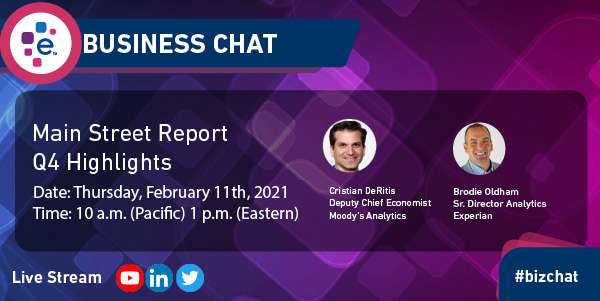
Main Street Report Q4 Highlights - Business Chat In this post we include a transcript from our February 11th Business Chat about the highlights in the most recent Main Street Report for Q4, 2020. We were joined by Cristian DeRitis, Deputy Chief Economist from Moody's Analytics, and Brodie Oldham, Senior Director of Analytics for Experian. [Gary]: Welcome to Business Chat. We're going to be talking about small business credit today—small business credit trends for Q4 with the release of the Experian Moody's Analytics Main Street Report. We've got the Deputy Chief Economist of Moody's Analytics, Christian DeRitis with us. Good morning, Christian. [Cristian]: Hi, good morning [Gary]: Good morning. [Gary]: And joining Christian is Brodie Oldham. He's a Senior Director of Analytics here at Experian. [Brodie]: Good morning. [Gary]: So glad you guys could join us today. So we're going to be taking a, look at the the highlights from the Experian Moody's Analytics Main Street Report just released. The report had three real standout items for me - the increase in hiring during Q4 that would be normally be expected. Delinquency rates declining to 1.21% and taxes as a main concern. We're showing that small businesses did add employees in Q4. It looks like those jobs appear to be funded primarily through credit. And businesses did keep the outstanding balances in check in Q4 with that moderate delinquency edging down to 1.21%, this time last year, it was around 1.60%. So, you know, there some good things there in the report, it seems kind of counter-intuitive, you know, when you read the headlines, but one of the things that also is starting to kind of resurge as a concern among business owners are taxes related to maybe a new administration and having things taking a different direction in terms of taxation. S. The thing that is probably on the minds of most small business owners and the nation really would be stimulus and getting some help for business owners. Biden has proposed a $1.9 trillion relief package. So Christian, I wanted to get your thoughts on the package, and if you could maybe cover some of the high points on it and what your thoughts are. [Cristian]: Yeah, sure. So they, you know, the $1.9 trillion package is an extension, if you will, of the cares act that we had last year or two, $2.4 trillion package, plus the additional stimulus that was passed at the end of December, really the purpose of those packages to my mind, it was largely preservation, right? We had households, small businesses that were really struggling under the weight of the pandemic and the associated closures. And so that assistance was really the lifeline to keep household finances in intact to some degree and to, and to preserve small businesses. Right? Last thing we wanted is to have millions of businesses failing. And then even when we get to the recovery stage, we don't have any, any of that, uh, that foundation to build off of the next, stimulus here. The 1.9 trillion that's been proposed, I think this package or some version of it is really intended to be stimulative to go to the next level where we have the vaccines kicking in the economy is recovering. You have consumers of being a little bit more positive and hopeful of the future here. And this package to me, is really designed to jumpstart some of the activity to ensure that we build some momentum and keep going in particular for small businesses. We have extension of the PPP program. That's the Paycheck Protection Program, this time around monies allocated are designed to be much more focused on the truly smallest businesses, many of which have been struggling and have few other options when it comes to credit. And so, I view that certainly as a positive as we, again, look forward to the future here, in terms of consumers coming back in leisure hospitality spending, coming back as people start to feel more comfortable after the vaccination efforts take hold. And so this, I, I do believe that this stimulus is certainly beneficial to ensure that we, we make it to that a more positive growth environment towards the end of the year, say the third or fourth quarter, I don't know that the full $1.9 trillion package will actually be passed. There's certainly a lot of debate around it, but I think some version of it that perhaps a scale-down package, maybe something closer to a trillion dollars will be passing that that certainly will be helpful for households and small businesses alike. [Gary]: Very good. Alright. Turning to you Brodie. One of the things that we saw again in the report would be credit and use of credit and businesses had kind of their appetite for credit in the Q4 timeframe had kind of declined. Did you have a comment on that? [Brodie]: I do, and, you know, it is a trend that we've been seeing through the summer. That pull back when we look at small businesses, just prior to the pandemic, what we saw them do is open up credit, looking for some longer term credit facilities that they could, uh, reach into and create some cushion for them as they looked forward and saw the pandemic growing, knowing that we would be entering some type of recessionary period. They knew that lenders would tighten up criteria as they went forward. And lenders did turn on their recessionary underwriting programs toward the beginning of last summer. And that really created a gap there for funding for small businesses and for their survival. Like Christian spoke to about stimulus, came in and provided some of that low cost alternative funding that small businesses might have gotten otherwise from banks or credit unions Fintechs across the marketplace. And so when we looked at that stimulus coming out, it really added or exacerbated that pull back that we saw of small businesses reaching out for this type of credit. Now we had the first round of stimulus that went really to all businesses, across the spectrum. When we look at the second poll, that's going to come out the second round of stimulus, that'll be part of the market what we're going to see is, and we're seeing already, a large number of those that were in the first round of PPP loans are entering the second round up to 93%. We've seen eighties, seventies across some of our different lenders. You know, at the second round is going to require some additional look at how a business's performance was through the third and fourth quarter if they have losses and, you know, those that picked it up in the first round, not all really needed it. And they took it from the perspective of we're going to take in the money. We're going to pay down some of our loans. We're going to, create some additional utilization space for us. And we saw some of that across the trends. And we'll talk about some of that in the upcoming Quarterly Business Credit Review. But what we're going to see as we go forward, is that, you know, as the pandemic lightens a bit, we see the vaccines take hold. We're going to see that some of the collections and foreclosure activity is going to slow a bit. We're going to see, you know, we're going to see those moratoriums come to an end. What that's going to create is a need for, some additional credit. And some of that's going to be beyond what will be provided in the stimulus packages. And so, as we go forward, as the market opens up, we see more foot traffic, businesses are going to go from that survival feel, into more of a future investment type of a growth feel. And in that they're going to be looking for banks and credit unions and fintechs and across the marketplace to again, look for opportunities to pick up some additional funding as we go forward. [Gary]: Very good. So gentlemen, you know, we're in Q1 right now, we should be seeing data for that coming in the early part of April, any thoughts on how this is going to break in terms of credit performance, business performance, if I guess it all depends on stimulus right now, and we've got what's happening in Texas and other things that are complicating things, any thoughts to, to close with? [Cristian]: Yeah. So from my perspective, I think it's still going to be a Rocky few months here. Assuming that stimulus does kick in and we continued to provide support to households and small businesses, I would expect the credit performance actually is going to remain fairly strong in the short term. And it's really, once we move beyond and remove those supports in the third, fourth quarter, we're going to have some counteracting forces, we'll have a stronger economy, so growth and labor market's coming back. Revenues are rising at a, at businesses. On the other hand, those supports are going away. There's a threat of somewhat higher interest rates. And so that I do expect to see a wave of bankruptcies and some additional delinquencies rising. But I don't, I don't expect that we're going to see a, a substantial shock. I think it's some more return to normality, the delinquencies and default rates are perhaps artificially suppressed for now. And they'll just gradually rise back to more normal level, but I don't know, Brodie, maybe you have a different opinion? [Brodie]: No, I think you're right on Christian. I think what we'll also see is you know, more new businesses entering the market. We saw a lot of closures that came toward the end of last year. We're going to see more reopenings, but those new businesses that are opening are going to have a hard time building credit as we come forward. They're not going to have that credit history that some of these that closed did. We'll see them start to build that credit history. We're going to see lenders some use different tools to differentiate credit risk for some of these new businesses and remarket. So we'll see originations begin to rise. We'll see some of that underwriting criteria loosen even continue to loosen into the first and second quarter. So it's going to give more opportunity for small businesses. Certainly as we get into the summertime, as, you know, foot traffic is going to increase, we're really going to be in a better place as a country. So I think we're going to really have an opportunity for businesses again, to go from that survival mode into what's my future, going to look like how do I invest to grow from here? [Gary]: Very good. Well, we'll be getting together again on March 16th. We're going to be doing more of a deep dive on the Experian Moody's Analytics Main Street Report, and that'll be the report for the Q4, Derek Grunfelder-McCrank is going to be joining us. That's Christian's colleague. And so I will see you gentlemen again on the 16th. And folks, if you would like to attend a webinar, there's a link here in this slide and also I will leave a link in the description for this video and a link to the report. If you haven't got your copy, please sign up. We'd love to get that report out there, have more people read it. Thanks very much for coming to Business Chat today. Thank you.
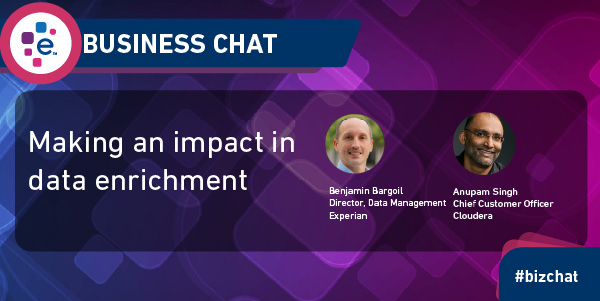
In this Business Chat, we sat down with Experian's Director of Data Management, Ben Bargoil, and Cloudera Chief Customer Officer, Anupam Singh to talk about the data management investments Experian is making in machine learning and A.I, and how these investments are helping our clients. Ben, can you share a little bit about some of the data challenges we are having here at Experian? [Ben]: Most of the challenges we've been facing and working closely with Cloudera and solving over the last say two years have been in response to growing demands from the marketplace, right? What was considered acceptable even two years ago, in terms of data coverage and data accuracy, is no longer meeting our customers' needs in the marketplace. And add to that the legacy processes and legacy environment that we operated in, we're challenged with keeping up with the variety, the volume, and the velocity of data that Experian has, and that coupled with our previous approaches to data management, that weren't flexible enough necessarily to empower these new approaches. Right? Again, most of what we wanted to solve were related to how we can continue to do what we're doing but do it in a much more efficient, much more impactful way for our customers. Anupama turning to you; what solution did Cloudera prescribe to Experian to help us address some of these challenges? [Anupam]: Machine Learning is only as good as the data, and so the solution that we provided is a comprehensive solution called Cloudera Data Science Workbench. Yes, the more charismatic part of the product is that you can do Machine Learning apps and build neural networks. But in reality, where we saw Experian needed the product is things like data de-duplication, classification. So it is almost a prologue to the machine learning problem. So that's the solution that we provided. Ben, can you explain how these investments help Experian clients? [Ben]: When we were creating this new, these new approaches, and this new team, one thing that I was determined that I needed this centralized hub, right. I wanted a central hub in which we could build an entirely new ecosystem, and as we worked with the Cloudera team, it became obvious to us that CDSW was going to be our best choice. [Ben]: So while we were investing in a CDSW, Experian had also been investing in our new technology environment, and putting those two together was the key to our success. Each one of these challenges has a direct line of sight to our clients. And most of them are based on direct feedback we've received from clients over the previous years if you will, and one of the great things that we've done inside of CDSW inside of the applications is measuring the impact to Experian customers. So we know confidently, we can state that millions and millions of customer interactions with our data have been improved thanks to the solutions we've built inside of CDSW. Anupam, did Experian have any unique challenges that stood out to Cloudera when we engaged with you? [Anupam]: Of course, with Experian, you know, I tell the team internally at Cloudera that we are all Experian customers indirectly, right? Anytime I'm going to buy something, Experian is in the workflow. So that always stands out for us. But the sheer scale of Experian, when you have almost a billion unique users that you're serving, you guys are one of the biggest Internet properties on the planet that nobody has heard of. When we were looking at the nomination for Data Impact awards, any small gains, 10% for Experian's actually a hundred million human beings on the planet, and so, that stood out for us. That's what got us excited about working with Experian on this problem, the sheer scale of it. How, how long did it take before you saw measurable results in working with the Cloudera solution? [Ben]: If you go back, let's go back two years ago when we were first creating this new ecosystem, and we first started our engagement with CDSW. There were the normal growing pains associated with a new environment, a new toolset, and a new team that we were onboarding onto Experian as well. So between the time we started working with Cloudera, it was many months until we had created a team, launched our first application, and started to make improvements to the database. Fast forward to today, we have many applications that have been created and launched in production, and the great thing is, this is very typical of most machine learning applications, you spend most of your time with the data, exploring, cleansing the data, creating the features you need to use within your machine learning application. [Ben]: But what we see is that the large bulk of the work, once we get to the point where we're ready to move into production through the combined power of CDSW and our new environment, we can make significant changes in a very short amount of time. I'm talking millions of improvements in a month or two months. To give you a good example of industry coverage, industry classification coverage, that was one of the challenges we wanted to solve was our customers wanted us to create more industry codes for businesses. So we spent many months building the application, doing all kinds of feature engineering. Within the course of about two to three months after we launched that application, I think we added somewhere in the 20 million range, new industry codes to our database. Again, lots of work on the front end, but as soon as we get into production, huge improvements in, in a short amount of time. What can you share about the Cloudera Data Impact Awards? [Anupam]: Our Data Impact Awards look for impact. We are all in the enterprise software business. Sometimes we forget what impact we have; if you have great fraud detection, you and I can safely shop on the Internet. We are talking today through some internet provider that runs its network management, and its network reliability analytics on top of Cloudera. For us, the Data Impact Awards are not just about our technology, but what impact we've had on the healthcare, banking, and telco systems of the world, of the world's government systems. That's how we measure, and it's fairly competitive every year. Can you share any criteria on what the judges looked for whenever they were choosing a winner? [Anupam]: What we look for, is this real in terms of, does it have an impact or was it just a technology experiment? We found with Velcro, for example, de-duplication of records is one of the biggest problems in machine learning, and the scale at which Experian de-duplicated records, meaning, knowing which Ben is the right Ben when I'm looking it up is a very real problem. All of us face it as a consumer— the same thing with establishing a corporate identity. As somebody who runs a very large business for Cloudera, sometimes you don't even know what is the actual name of the customer. So the idea that you can resolve the name of a customer is a real problem. So taking these two or three real problems, we saw the level of impact that Experian was having on its customers, but more importantly, on its indirect, all the consumers in the world, and that stood out for us. Ben, what has the response been from Experian clients since deploying Cloudera? [Ben]: Some of the problems and challenges we've been addressing are more behind the scenes, under the covers, like what Anupam just mentioned, improved entity resolution, improved structural integrity. So those may or may not be necessarily as overt as some of the other challenges we saw, like the industry classification example we mentioned, right? Adding all of those millions and tens of millions of codes to our database, our customers have a direct line of sight to that. We've received very positive feedback from the marketplace in terms of embracing these new approaches and being able to solve those challenges. I always like to say I'm not quite declaring victory on any of these challenges yet, but, you know, the end of the war is in sight on some of them. We've almost completely removed this as an area of opportunity, and we are meeting the needs of the marketplace. Subscribe to our YouTube Channel
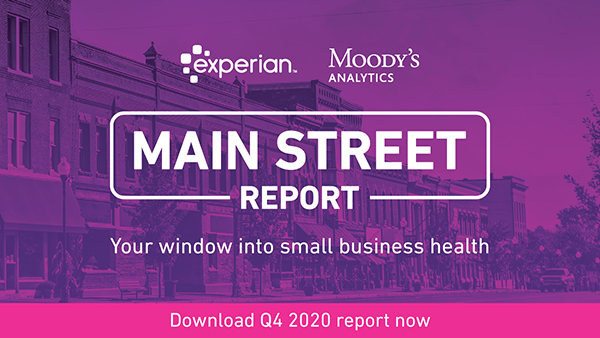
Experian and Moody's Analytics have just released the Q4 2020 Main Street Report. The report brings deep insight into the overall financial well-being of the small-business landscape and offers commentary on business credit trends and what they mean for lenders and small businesses. Small businesses increased hiring during the holiday season, offsetting some of the pandemic's job losses. Many of these jobs were funded by credit while companies paid down outstanding debt. This trend of paying down debt caused moderately delinquent balances to decline to 1.21 percent from 1.60 percent during the same time last year. There has yet to be a decisive upturn in delinquency and bankruptcy, as would be expected following the pandemic lockdowns of the previous year. With a change in administration, small businesses are feeling concerned about taxes, as noted in recent NFIB surveys. But these growing concerns did not dampen borrowing or hiring during the fourth quarter. Business Chat Live Watch the replay of our interview with Cristian DeRitis from Moody's Analytics and Brodie Oldham. Join us for the Q4 Quarterly Business Credit Review You can also save your seat for our upcoming Quarterly Business Credit Review webinar for a deep dive on the latest report. Date: Tuesday, March 16th, 2021 Time: 10 a.m. (Pacific) | 1:00 p.m. (Eastern) Save My Seat
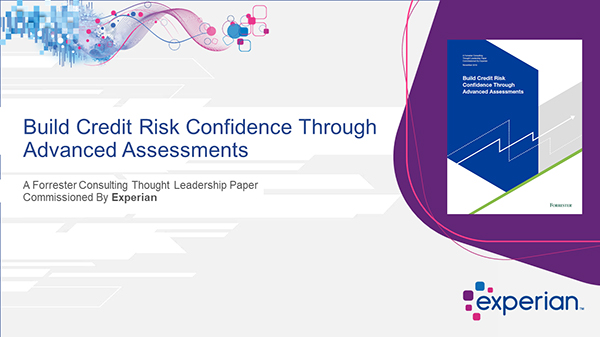
Michael Myers, Experian's Vice President of Products, assembled an impromptu roundtable discussion in March 2020 to discuss some of the key findings in a Forrester Study titled "Build Credit Risk Confidence Through Advanced Assessments." Mike is joined by Ann Skibicki, Sr. Director of Product Management and Brodie Oldham, Director of Analytics Consulting. What follows is a lightly edited transcription of their discussion. Build Credit Risk Confidence Through Advanced Assessments [Mike]: Hi everyone. I'm Michael Myers. I am the Vice President of Products here at Experian Business Information Services and looking forward to talking to you today. We're going to share a number of findings from our most recent Forrester Research project entitled “Build Credit Risk Confidence Through Advanced Assessments”, and I'm joined today by Ann Skibicki, a Senior Director on our Product Management team. We're also joined by Mr. Brodie Oldham all the way from Texas. He is a Director of Analytics Consulting here at Experian. [Mike]: All right guys, let's jump into it. We recently commissioned Forrester and ended up with our most recent study and what we want to do is share some of the key findings. Really the goal of the overall project was to get a sense of risk-based decisioning and what some of the firms in the industry's plans are around the future of their credit risk assessment practices. I'll start at a high level discussing some of the key findings and then with Ann and Brodie's help, we're going to dig into each one. [Mike]: So, finding number one, only half of decision-makers are very confident in their businesses, current approaches to risk management. The second finding, businesses struggle to deploy advanced analytics or automate account reviews, and last but not least, our third finding we're going to discuss today is most businesses are looking to a credit risk evaluation partner to evolve their risk solutions. [Mike]: Okay so, before we jump into those, let me just give you a little bit of background about who we talked to and their background firmographics. We certainly wanted to talk to decision-makers, so we went after those at the C level down through Vice President, Director Management. We certainly want to make sure they were part of this conversation and had an active role in it. So, we talked to everyone that was just considering starting this journey, those that were mid-flight of the journey, and those that had actually implemented some more automated analytic approaches. [Mike]: One more slide on the background. We needed to make sure we had a wide variety across the spectrum of company sizes. You'll see on this graph on the left, you know, really the sweet spot in that mid to large size company. But we also covered the small business micro-business even as well as some of the larger firms out there. And with that comes really a wide array of industry verticalization. Everything from what you see here on the top right, financial services down to the agricultural food and beverage industry. [Mike]: Okay. So let's jump into it guys. Finding number one only of decision-makers are very confident in their business’s current approaches to risk management. Ann let's start with you. Give us your, take some of your thoughts. [Ann]: Uh, sure. Mike. Yeah, I think that that is interesting. But I think you do have to dig in a little bit further by the client's evolution as to where they're at in the adoption of advanced analytics and decisioning to really make meaning of that stat. You'll find that the folks that are actually adopting advanced analytics and decisioning are already on their path, are much more confident, almost twice as confident as the folks that have not implemented or have no plans at this point to implement. [Ann]: So I think there is something interesting to be said there about the level of competence that folks are having with their processes and advanced analytics, particularly with the folks that are already adopting. Brodie anything to add? [Brodie]: Well, sure Ann. As I've looked at this and we've talked to clients and part of the engagements that we've had, we find that a lot of times that confidence that they have has pulled back a little bit because they lack some of the automation there. We look behind the curtain, and we see it. What they end up with are inconsistent decisions. And so, what we're trying to do is give them a pathway or a framework to work with, and Forrester really showed us that they needed that. Some of the things that they need are a strong benchmark to start, you know, where they're really going to start their path. Those advanced analytics that you talked about are important, we have new methodologies that we can deploy and then a place to deploy them. Really that decisioning platform is super important for their confidence. [Brodie]: So when they come out for that progression and for the performance to be there, they really need to have that confidence to progress their sales cycle, and we see that those that don't have that plan to implement. Only 12% of those folks really, they're not planning to grow. 12% of those that are planning to grow in the near future really aren't going to grow. So we found that in the Forrester study, it's very exciting to see. [Brodie]: But when we look at those that are really having some success. I know Mike in the Forrester study some of the things, there were some key points that we found that were helping some of those that are really pushing forward and pushing that limit to overcome. What are some of the challenges that they might be facing? [Mike]: Yeah, got it. Couldn't agree more Brodie and thank you both. Great insights on that first finding. Tell you what, let's jump into the second one. Finding number two, businesses struggle to deploy advanced analytics or automate account reviews. Let’s start with you Brodie, but I'll add a little bit of my insight on this one too. [Mike]: In my experience with our prospects, and with our clients, you know, account reviews are often overlooked, especially when the economy is doing as well as it is. You know, everyone's focused on origination, opening accounts, but they tend to forget the need to really focus on account reviews and really managing those accounts. So, Brodie give me some of your thoughts. [Brodie]: When we're looking at the Forrester study it really highlights what we've been seeing with our clients. We know that some of the strategies that we've been taking are implementing some of these more mature methodologies, more advanced cutting-edge methodologies for Machine Learning, and in our processes for an account review, even originations, but account review especially. We've seen lift over those tried and true logistic regression type models with our new Machine Learning models — 12% 15%,17% plus percent. So really some great value that's being added in these Machine Learning type models. [Brodie]: The hardest thing that we see with our clients is being able to install what we have here in this new methodology into the process, so into their account review process. With some of the new microservices that we have in place, we can deploy those. We have sub-second turnaround times with the new methodologies that we have. Which is really industry-leading, and it takes us into a place where our clients can deploy either models that we've built for them or models that they've built themselves and deploy it here at a significantly lower cost and they can really do it themselves. I know Ann, some of these, when we talk about implementing a key to that is data. Do you have some points that you want to make on that? [Ann]: Yeah, I was going to kind of bring it back to the fundamentals because when I read the study and looked at the results for me, a couple of things stood out. Not only were our clients and their survey respondents struggling with IT budget and system constraints, which I think we would all agree is a challenge across the board. What I thought was interesting was that they're having data quality challenges and that was across the board. Whether they were just starting to implement or if they were on the path of implementation. Everybody seemed to have really the same challenge with standardizing the data, finding good fill rates of the information of where the data's not complete or even the data privacy issues. I'll say in working with some clients recently, I would definitely agree with this. You know, data standardization, data quality, especially with data and multiple systems becomes pretty challenging. And then you really want to leverage that information, right? Unlock the power of the data to be used in the advanced analytics portion, whether it's for portfolio management or new account acquisition. It can be a definite challenge for sure. [Mike]: Great job guys. You know, I just want to add to that too. I think you both hit on some key points. ML, Machine Learning, A.I. buzzwords, right? Really hot in this space right now. It’s really important not to forget what problem are you trying to solve, what are you trying to accomplish, and then how can you go about doing that? I think Brodie, you outlined some really good points of hey double-digit lift. That's no joke. How can we at Experian possibly help you implement that? And we do have a number of ways and a number of analysts that are really experienced in just that. [Mike]: So, bringing it back to your point too, Ann, it's easy to forget some of the basics, tie that together and you really have a compelling proposition. All right guys let's go to the third and final finding from our Forrester study. Most businesses are looking to a credit risk evaluation partner to evolve their risk solutions. Ann why don't we start with you. Talk to me about this finding. [Ann]: Yeah, I thought this was interesting as well. A very strong call to action for me. I saw that with our clients and respondents, this is not necessarily an emerging need. About 75% of the respondents are taking immediate action within the next 12 months. So, I'm happy to see that folks are definitely starting to adopt these new methodologies, are really looking at ways to transform their business. And that is happening right now at the present time. I'm sure Brodie, you're probably hearing a lot from clients working in the analytics space of folks that are looking to us maybe want to share some of your insight. [Brodie]: Well, they certainly are Ann, the way that we're really drawing this in to show the value they're there, they get the feeling that they're on the cutting edge and we really want them to see that, and as our clients move forward with us in partnership, to build out their account management and even their origination systems, as they're including some of these Machine Learning and advanced techniques into their processes. It's not just the performance that they're getting here, as far as their numbers and the dollars that they're earning, but their sales teams are getting that lift as well. And I like to call it the swagger factor. So, you mentioned a little bit earlier, you know, in this Forrester study what you're going to see is that swagger factor, which is up about a 200% increase in that confidence level that our clients are really feeling here. [Brodie]: When we look at those in this study that didn't feel like they had a good onboarding process, about 28% didn't in the group that wasn't going to implement in the next two years. So there are groups that are waiting to implement or looking out in the future to take these next steps into Machine Learning. The ones that are doing it more quickly in the next six months or so, 85% of them feel like they're really on the cutting edge. They're moving forward, they're going to have great sales and growth in the next six to 12 months. That's where the swagger factor comes in. This really reinforces the good value that we're seeing in a partnership with Experian. And Mike, can you tell us a little bit about how to get some of this information? [Mike]: Yeah, you got it. Brodie, thank you so much. We can help you. Let us help you increase your swagger factor, but first I just want to say thank you, Brodie, thank you Ann for joining us today. Really what we have available is a copy for download of this Forrester research study. It's available over on experian.com so please join us there and we'd love to talk to you further. We do have quite a bit of experience as you heard from Ann, Brodie, and myself today, and we'd love to help you on this journey. Thanks so much for joining us today. If you would like to download a copy of the full report visit our credit risk assessment page. Forrester Credit Risk Assessment
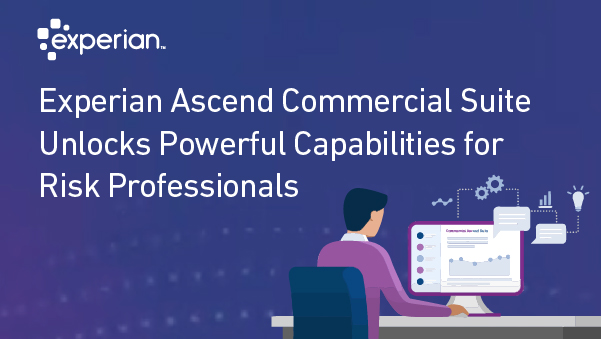
Making fast, accurate decisions on businesses is critical, especially during uncertain times. Having an edge on your competition matters, from productivity to profitable growth. For risk managers and data analysts, the stakes could not be higher. In response to that market need, Experian Business Information Services recently announced the availability of the Ascend Commercial Suite, a data and analytics platform which currently enables the following three capabilities: Commercial Analytical Sandbox - enables immediate access to multiple data sets, including our commercial, premier consumer attributes, and SBFE data, with new data snapshots automatically added monthly. Experian built Commercial Analytics Sandbox on the same OneExperian Technology Platform that won a FinTech Breakthrough Award for Best Overall Analytics Platform in 2019. It is compatible with multiple leading analytics packages and cutting-edge tools, including RStudio, R, Python, H2O, and SAS Viya. Benchmarking Dashboard - Small Business Financial Exchange members can tap into powerful portfolio views using Tableau. The Benchmarking Dashboard offers access to all data and multiple data sets so clients can compare their portfolios against peer populations, and analyze new market segments for potential expansion. Ascend Data Services - For clients who want to run analytics using their software tools. Ascend Data Services offers a delivery method that enables the flow of linked data into a client-owned environment, making Ascend Commercial Suite extremely flexible to whatever tools clients are using. Eliminate barriers to data and analytics while holding down IT costs Our clients have often mentioned the time and labor-consuming process of appending archive data. They also describe lengthy procurement processes to acquire additional data. With on-demand access to the freshest data, clients can focus on customers and be more responsive to market changes by providing KPI’s to key stakeholders, all while holding down IT costs. Manage your portfolio more effectively You can create Tableau-enabled dashboards to monitor portfolio performance and quickly identify areas of strength or concern without running custom reports every month. Spotting shifts in risk profiles or identifying cross-sell and up-sell opportunities helps you to maximize portfolio performance. Model development Perhaps the most potent aspect of Ascend Commercial Suite is the modeling tools. Here you can design, develop, and validate models (including marketing, risk, collections, 3rd party) and scorecards to find, approve, and manage new and renewal accounts. Run retroactive analyses on the fly to establish risk-based credit loans or loan amounts to better control through-the-door risk and prevent loan losses. We are incredibly excited about the possibilities Ascend Commercial Suite unlocks for our clients. If you would like to learn more or schedule a demo, please reach out to Experian today.
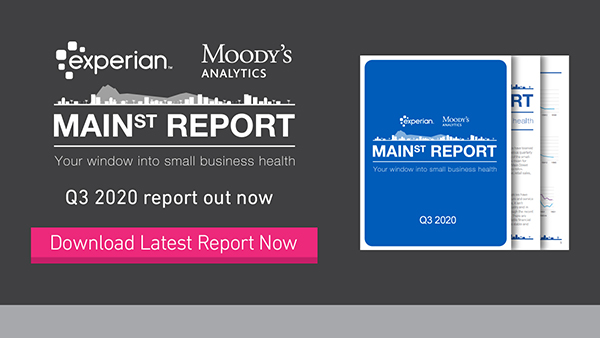
Experian and Moody's Analytics have just released the Q3 2020 Main Street Report. The report brings deep insight into the overall financial well-being of the small-business landscape, as well as offer... Experian and Moody's Analytics have just released the Q3 2020 Main Street Report. The report brings deep insight into the overall financial well-being of the small-business landscape, as well as offer commentary on business credit trends and what they mean for lenders and small businesses. In a fight for survival, small businesses have turned to layoffs and borrowing as they attempt to reach the other side of COVID-19. The increased borrowing is helping to mask rising late-stage delinquencies and bankruptcy. But these tactics can only mask weakness for so long. With another round of government stimulus unlikely to arrive before year's end, small businesses will need to borrow for survival again. While we did see some jobs come back in Q3, small business payrolls have shrunk by more than 2 million from this time last year. The hardest hit are those businesses with 1-19 and 20-49 employees; both of these groups saw payrolls shrink by 1 million employees. The 31-90 days past due (DPD) delinquency rate on small business credit plunged to 1.25 percent in the third quarter. This ended the streak of increasing delinquency we had observed for the last year. However, this is likely to be short-lived, as the US appears to have entered a new phase of the COVID-19 pandemic with cases again on the rise. Commercial and Industrial loans continued to run hot. C&I numbers are a lagging indicator, so the latest numbers reflect the second quarter. At that time new C&I lending was 21 percent higher than in the same period a year ago. If you would like to get the full analysis of the data behind the latest Main Street Report, join us for the Quarterly Business Credit Review webinar.
